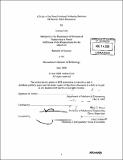| dc.contributor.advisor | Mary C. Boyce. | en_US |
| dc.contributor.author | Greb, Andrea (Andrea L.) | en_US |
| dc.contributor.other | Massachusetts Institute of Technology. Dept. of Mechanical Engineering. | en_US |
| dc.date.accessioned | 2009-06-30T16:24:57Z | |
| dc.date.available | 2009-06-30T16:24:57Z | |
| dc.date.copyright | 2008 | en_US |
| dc.date.issued | 2008 | en_US |
| dc.identifier.uri | http://hdl.handle.net/1721.1/45843 | |
| dc.description | Thesis (S.B.)--Massachusetts Institute of Technology, Dept. of Mechanical Engineering, 2008. | en_US |
| dc.description | Includes bibliographical references (leaf 61). | en_US |
| dc.description.abstract | Elastomers are able to undergo relatively large deformations in an elastic manner, which makes them the material of choice for a wide range of applications. In some cases, filler particles, such as carbon black, are added to the elastomer to alter the mechanical behavior when subjected to different loading conditions. When subjected to cyclic loading conditions, elastomers undergo stress-induced softening, known as the Mullins effect, and this softening behavior is influenced by the amount of filler particle present. The softening is considered to be an evolution of the soft and hard domain microstructure of the material, with the effective soft domain increasing with stretch. In this study, finite element analysis will be used to understand the softening behavior of particle reinforced elastomers. The softening behavior of the parent elastomer will be modeled using a constitutive model proposed by Qi and Boyce (2004). Nonlinear finite element analysis using the ABAQUS code was used to model elastomers with various volume fractions of filler particles, and the stress-strain behavior of the composite and evolution of the soft domain within the matrix is computed. The addition of filler particles was found to increase the overall stiffness of the elastomer, but also to increase the stretch-induced softening, and to alter the distribution of soft domains within the material. The presence of occluded regions of matrix material was also found to have a significant effect on softening behavior. | en_US |
| dc.description.statementofresponsibility | by Andrea Greb. | en_US |
| dc.format.extent | 61 leaves | en_US |
| dc.language.iso | eng | en_US |
| dc.publisher | Massachusetts Institute of Technology | en_US |
| dc.rights | M.I.T. theses are protected by
copyright. They may be viewed from this source for any purpose, but
reproduction or distribution in any format is prohibited without written
permission. See provided URL for inquiries about permission. | en_US |
| dc.rights.uri | http://dspace.mit.edu/handle/1721.1/7582 | en_US |
| dc.subject | Mechanical Engineering. | en_US |
| dc.title | A study of the stretch-induced softening behavior of particle filled elastomers/ | en_US |
| dc.type | Thesis | en_US |
| dc.description.degree | S.B. | en_US |
| dc.contributor.department | Massachusetts Institute of Technology. Department of Mechanical Engineering | |
| dc.identifier.oclc | 319626871 | en_US |
